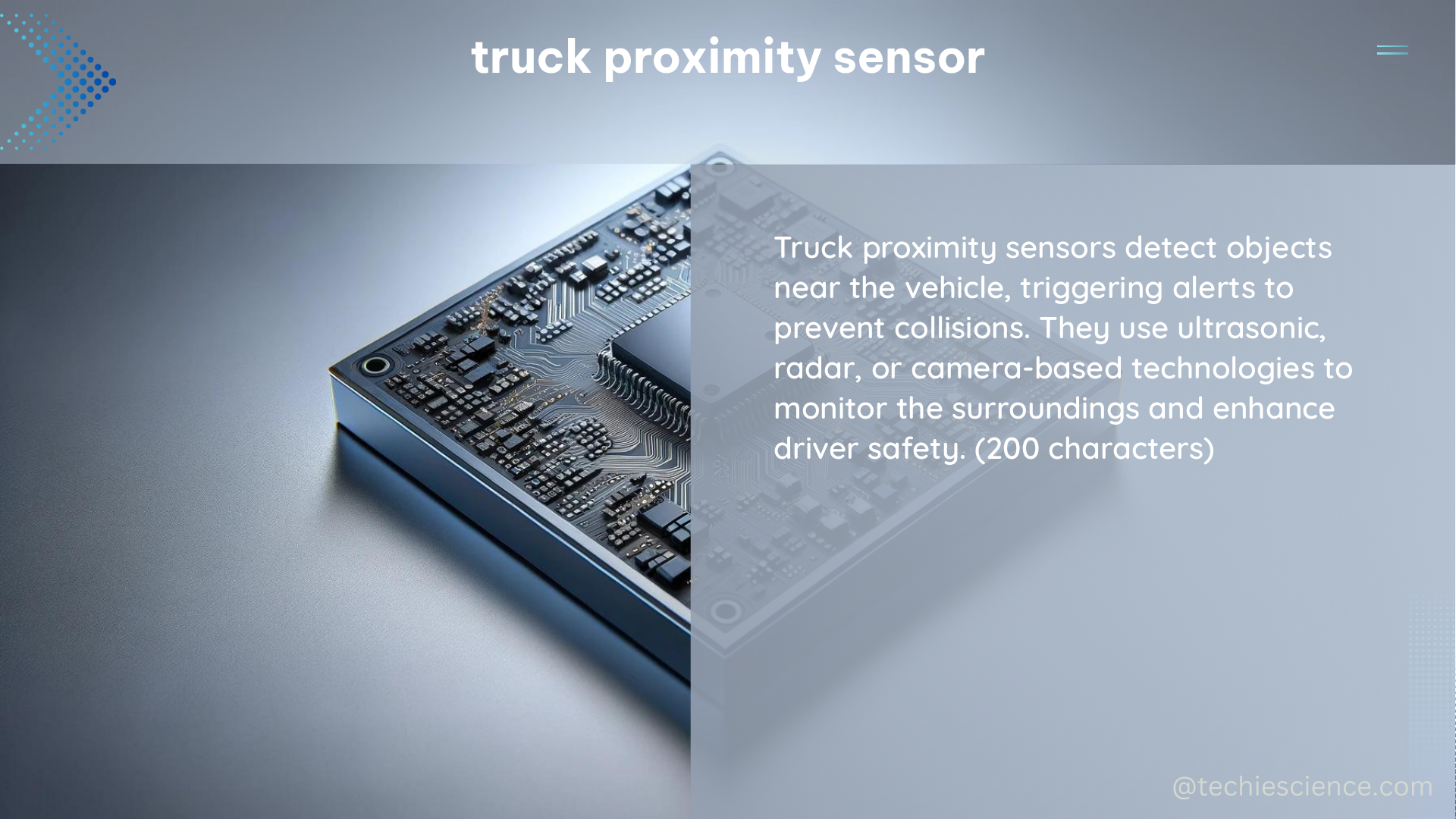Truck proximity sensors are essential components of advanced driver assistance systems (ADAS) that enhance the safety and efficiency of commercial vehicles. These sensors detect the presence and distance of objects in the vicinity of a truck, enabling features such as collision avoidance, lane departure warning, and adaptive cruise control. In this comprehensive guide, we will delve into the various types of truck proximity sensors, their technical specifications, and best practices for their selection and integration.
Types of Truck Proximity Sensors
Truck proximity sensors can be classified into three main categories: ultrasonic, infrared, and radar sensors. Each type has its own unique characteristics and applications, making them suitable for different scenarios.
Ultrasonic Sensors
Ultrasonic sensors, such as the HC-SR04, emit high-frequency sound waves and measure the time it takes for the echo to return. These sensors have a range of up to 4 meters and an angular field of view of approximately 15 degrees. The measurement resolution is typically around 1 cm, making them suitable for applications that require precise distance measurements.
Ultrasonic sensors are particularly effective in detecting objects in close proximity to the truck, such as during low-speed maneuvers or when parking. They are also resistant to environmental factors like dust, fog, and rain, making them a reliable choice for outdoor applications.
Infrared Sensors
Infrared sensors, such as the Sharp GP2Y0A21YK0F, emit infrared light and measure the reflection to detect the presence and distance of objects. These sensors have a range of up to 80 cm and an angular field of view of about 24 degrees. The measurement resolution is around 1 mm, providing high-precision distance measurements.
Infrared sensors are well-suited for applications that require a compact and lightweight design, such as in-cab monitoring systems or blind spot detection. They are also less affected by environmental factors like temperature and humidity compared to ultrasonic sensors.
Radar Sensors
Radar sensors, such as the Delphi ESR, use radio waves to detect the presence and distance of objects. These sensors have a range of up to 250 meters and an angular field of view of approximately 15 degrees. The measurement resolution is around 10 cm, making them suitable for long-range applications.
Radar sensors are particularly effective in detecting objects at a distance, such as in adaptive cruise control or collision avoidance systems. They are also less affected by environmental factors like rain, snow, or fog compared to other sensor types.
Sensor Selection Criteria

When selecting a truck proximity sensor, it is essential to consider the following factors:
- Range: Determine the required detection range based on the specific application and the size of the truck.
- Angular Field of View: Ensure that the sensor’s field of view covers the necessary area around the truck.
- Measurement Resolution: Choose a sensor with a resolution that meets the accuracy requirements of the application.
- Environmental Factors: Consider the operating temperature, humidity, and vibration levels that the sensor will be exposed to, and select a sensor that can withstand these conditions.
- Interference Mitigation: Ensure that the sensors do not interfere with each other by placing them at a minimum distance of 10 mm and using shielding or filtering techniques.
Sensor Integration and Calibration
Proper integration and calibration of truck proximity sensors are crucial for their effective performance. Here are some best practices:
- Sensor Placement: Strategically position the sensors around the truck to provide comprehensive coverage and minimize blind spots.
- Sensor Alignment: Ensure that the sensors are properly aligned to accurately detect objects in the desired direction.
- Sensor Calibration: Calibrate the sensors to ensure accurate distance measurements and proper triggering of alerts or actions.
- Sensor Fusion: Combine data from multiple sensors, such as proximity sensors, accelerometers, and GPS, to enhance the overall system performance.
- Software Integration: Integrate the sensor data with the truck’s on-board computer or ADAS system to enable advanced features like collision avoidance and lane departure warning.
Conclusion
Truck proximity sensors are essential components of modern commercial vehicles, providing enhanced safety and efficiency. By understanding the different types of sensors, their technical specifications, and best practices for selection and integration, fleet managers and truck manufacturers can optimize the performance of their ADAS systems and improve the overall driving experience.
References
- Data Tabulation/Recording of Proximity Sensor using Arduino: https://forum.arduino.cc/t/data-tabulation-recording-of-proximity-sensor-using-arduino/578666
- Truck industry classification from anonymous mobile sensor data using machine learning: https://www.sciencedirect.com/science/article/pii/S2046043021000563
- Truck Activity Pattern Classification Using Anonymous Mobile Sensor Data: https://scholarworks.uark.edu/cgi/viewcontent.cgi?article=5054&context=etd
- Instrumentation of Navistar Truck for Data Collection: https://mdl.mndot.gov/_flysystem/fedora/2023-01/201301.pdf

The lambdageeks.com Core SME Team is a group of experienced subject matter experts from diverse scientific and technical fields including Physics, Chemistry, Technology,Electronics & Electrical Engineering, Automotive, Mechanical Engineering. Our team collaborates to create high-quality, well-researched articles on a wide range of science and technology topics for the lambdageeks.com website.
All Our Senior SME are having more than 7 Years of experience in the respective fields . They are either Working Industry Professionals or assocaited With different Universities. Refer Our Authors Page to get to know About our Core SMEs.